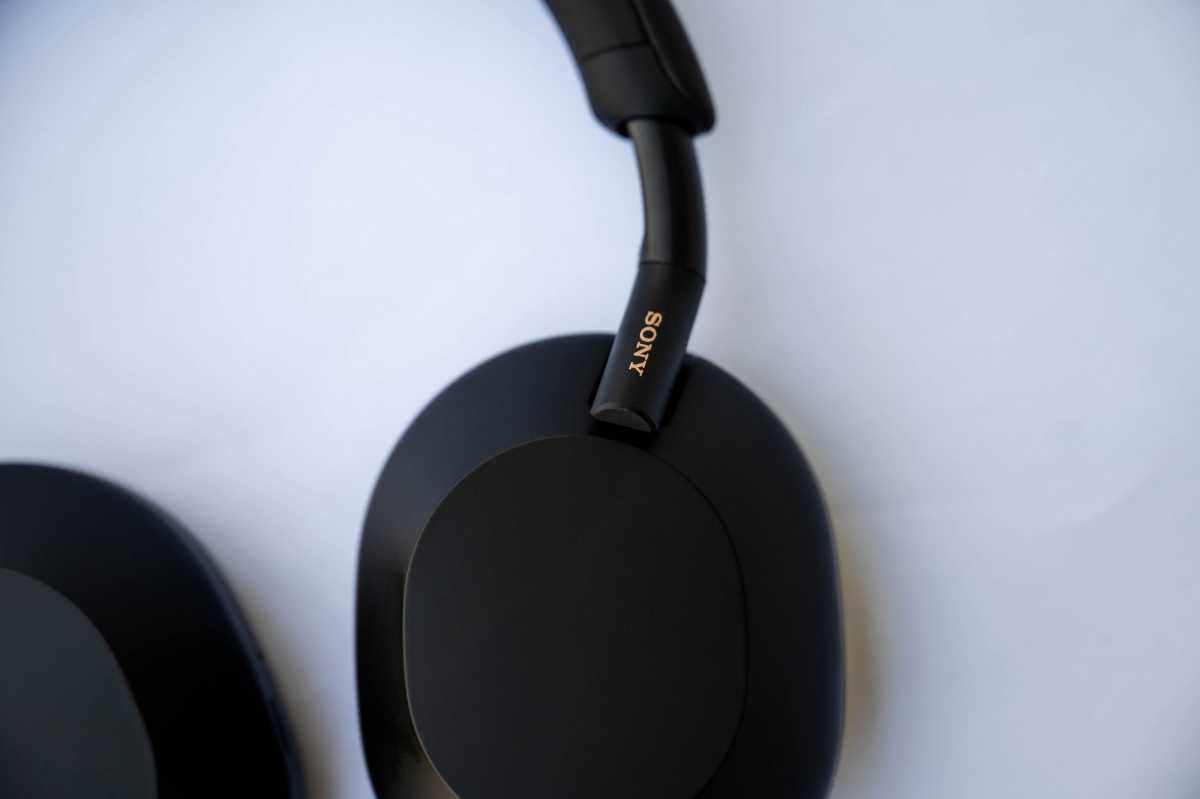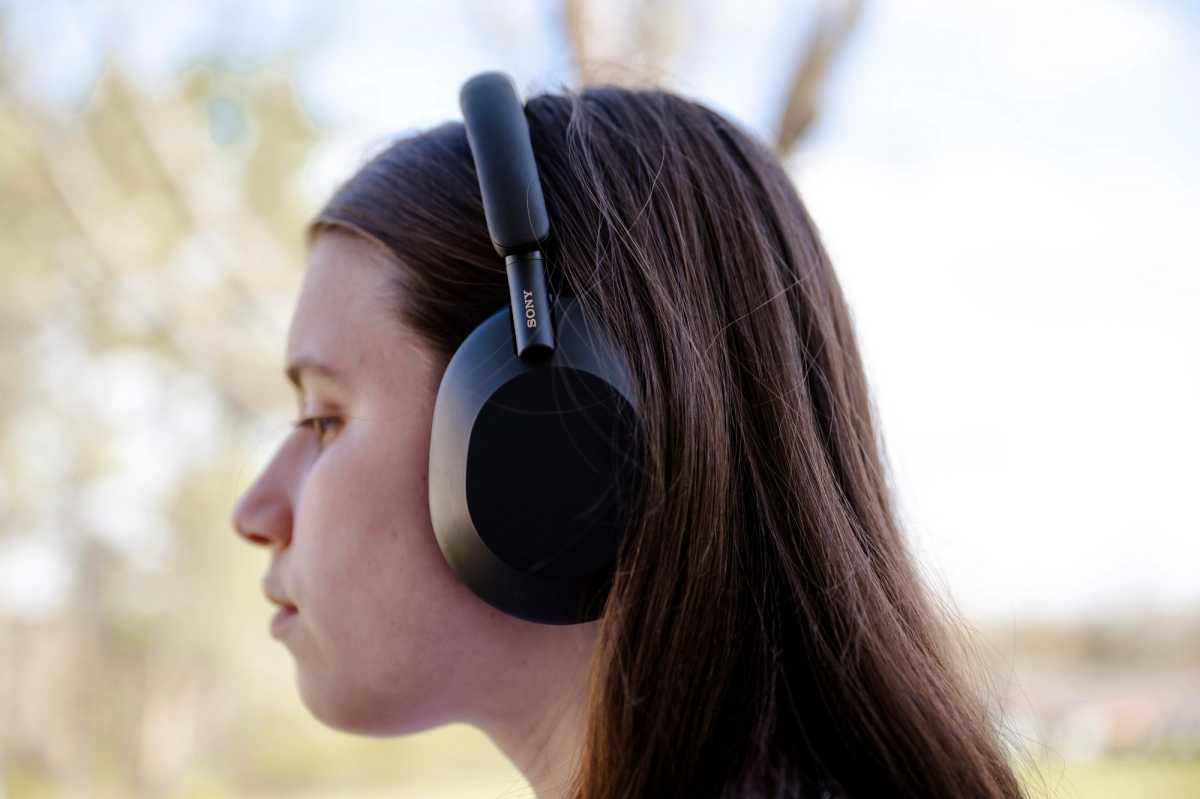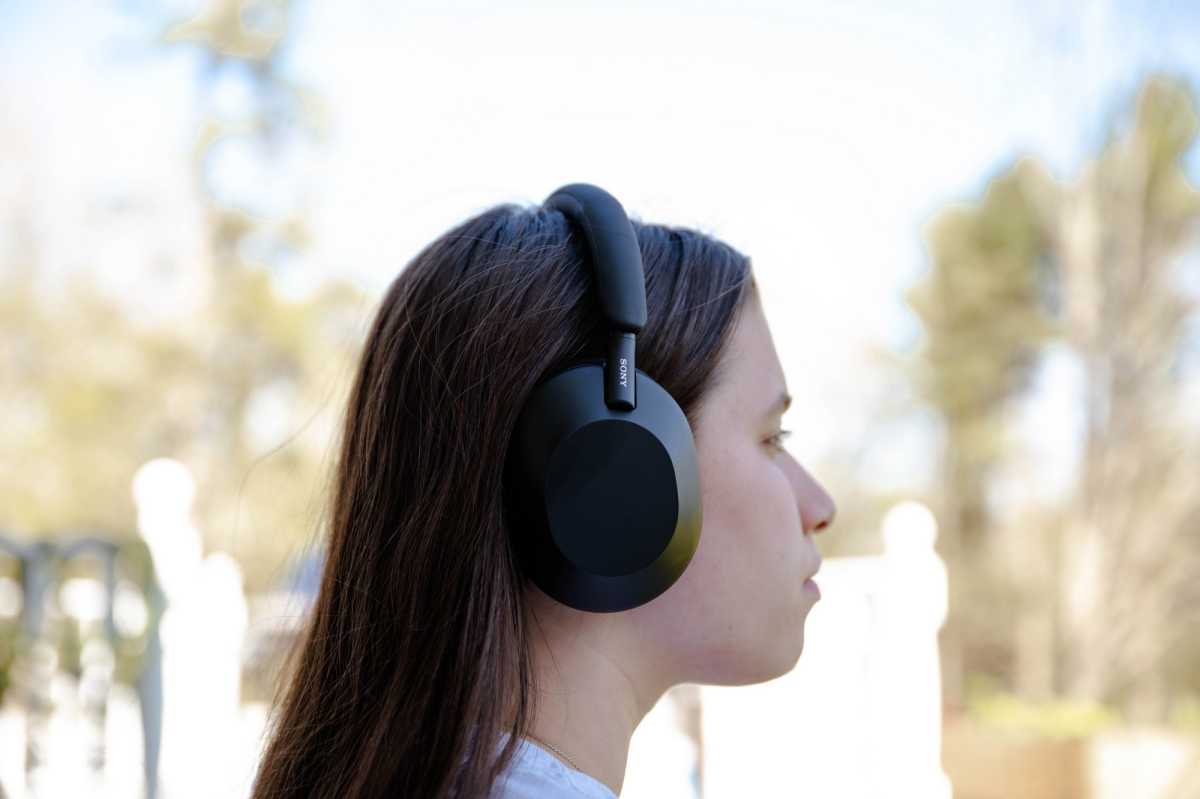At a glance
Expert’s Rating
Pros
- New carbon fiber driver delivers intoxicating sound
- Best-in-class noise cancellation is better than ever
- Outstanding adaptive noise-cancelling performance
- Beam-forming mics make near-perfect calls in noisy environments
Cons
- Noise cancellation subject to the occasional audible artifact
- No support for aptX codecs
Our Verdict
This headphone is nothing short of spectacular, delivering both exceptional sonic performance and stellar active noise cancellation.
Price When Reviewed
Sony WH-1000XM5: $399.99
Best Prices Today: Sony WH-1000XM5
Sony’s over-ear noise-cancelling headphone, the WH-1000XM4 has ruled the roost as our top pick in noise-cancelling headphones. Well, I have news: The king is dead. Sony has an all-new noise-cancelling headphone–the $400 WH-1000XM5—and it’s nothing short of spectacular.
Sony’s WH-1000XM5 isn’t a minor revision of the WH-1000XM4, it represents a clear rethinking of the product from top to bottom. And the results are overwhelmingly positive.
This review is part of TechHive’s coverage of the best noise-cancelling headphones, where you’ll find reviews of the competition’s offerings, plus a buyer’s guide to the features you should consider when shopping for this type of product.
Everything starts with Sony’s plastic-free packaging. This new model comes in your choice of black (the color or my review sample) or silver. The latter is more accurately described as a light cream color, and it’s a stunning improvement over the previous generation’s palette.

Sony redesigned its flagship noise-cancelling headphone from the ground up. Virtually every component has changed compared to the previous generation.
Ephe Nicolakis
When I first lifted the WH-1000XM5 at a private Sony event, I was immediately struck by how light they are. “Featherweight” came to mind. Even though there’s only about four grams difference between the 150-gram WH-1000XM5 and their 154g predecessor, the XM4, when I held both models in my hand, the difference was noticeable. And that carries over to wearing them, too. It’s almost like not having anything on your head at all.
The light weight is due in large part to the continued use of plastic as opposed to aluminum armbands. I understand why Sony pursued this design decision; nevertheless, every time I see all-plastic armbands, it makes me wonder about long-term durability compared to an armband fabricated from aluminum. All that said, there’s nothing cheap about the WH-1000XM5’s build.
As with previous generations, the ear cups fold flat. But this time, they fold into a completely redesigned bell-shape—one that deserves special attention. It looks fabulous and feels like a significant upgrade. A new magnetic lid holds the included 3.5mm analog and USB-C charging cables securely. When the headphones aren’t present, the hardtop case can collapse almost flat, becoming very easy to shove into a backpack or suitcase. This degree of attention to detail characterized my entire experience with the WH-1000XM5.

The extension point of the WH-1000XM5 is much closer to the ear cup than it is on previous generations.
Ephe Nicolakis
The WH-1000XM5 itself looks similar to its predecessor, but with significant refinement and detailed attention to aesthetics. Sony has minimized the new model’s lines and cleaned up its curves to hide the points of assembly. A new synthetic leather material envelops nearly the entire headband. As a result, the armband’s extension point is much closer to the ear cups, which slightly changes the angle of how the headphones fit to your head. The headphones have a stark “U” shape to them, compared to the rainbow-like arc of the WH-1000XM4. After long listening sessions, the WH-1000XM5 did apply slight pressure to the top of my head; this became less of an issue after the headphones were broken in.
Sony redesigned the ear cups significantly and are now oval-shaped instead of round. They’re noticeably roomier too, finally addressing a long-standing issue of Sony’s ear cups feeling a bit snug.
The acoustically transparent cloth inside the ear cups has been repositioned, too. This minor attention to detail gives the headphones a much cleaner, more modern look.
Sony WH-1000XM5 listening tests
The best noise-cancelling headphone in the world isn’t worthy of your dollar if it doesn’t first deliver a great audio performance. Among the most significant internal upgrades to the WH-1000XM5 Sony’s decision to switch to a 30mm carbon fiber driver. Carbon fiber is prized for its rigidity and low mass, which makes it an excellent choice for a headphone driver. And it delivers exceptional audio performance here.
I tested the Sony WH-1000XM5 with an iPhone 12 Pro and a Fiio M9 high-res digital audio player, which supports Sony’s LDAC wireless codec. Source material included streams from Tidal, Apple Music, and the Roon app connected to my Roon Nucleus music server. I optimized the Tidal app with the Headphones Companion app for Sony’s 360 audio.
The Sony WH-1000XM5’s sonic signature is simply outstanding for the price point, and is for all practical purposes unaffected by noise cancelling or ambient-sound mode. I found the WH-1000XM5 to be delicate, detailed, and dynamic. If you’re an audiophile like me, you’ll be well-pleased with its overall performance.
I loved the Sony’s bass response and I think you will too. Bass is dynamic and refined. The WH-1000XM5’s bass lines on Imagine Dragon’s “Thunder” and Billie Eilish’s “Bad Guy” pulsated with control and dug deep when called. There wasn’t a hint of bass bloat anywhere, no matter the song or genre I tried.
Vocals were consistently clear and timbrally accurate. I was hard pressed to find major fault with my repertoire of Adele, Alicia Keys, Sarah McLachlan, Katie Melua, U2, the Revivalists, Natalie Merchant, and so many other artists.

Sony’s new WH-1000XM5 won’t crowd your ears as much as the earlier generations of this headphone did.
Ephe Nicolakis
The WH-1000XM5 gripped control of each instrument in space and time. I’ve found ColdPlay’s “Sunrise” to be an interesting test of a system’s control, and Sony’s WH-1000XM5 did a marvelous job with the track.
While I found little to fault at the $400 price point, I can say that the WH-1000XM5 has a tendency toward a flattened soundstage with an overly warm midrange. And as good as those carbon fiber drivers are, they can’t compare to beryllium. Most will be oblivious to these nitpicks, which you can only discern if you’re comparing the WH-1000XM5 to the likes of the Mark Levinson No. 5909 headphone I’m in the process of evaluating, but that headphone tips the scales at almost $1,000.
The best headphone noise-cancellation going
Now that you know Sony’s WH-1000XM5 sound fantastic, let’s discuss its noise-cancellation performance, which I can sum up with just two words: Crazy good. Strapping a pair to your head is like stepping into a veritable cone of silence. Enabling noise cancelling on a noisy train or NYC subway erased nearly every noise: Engine sounds, the whir of HVAC systems, creaking metal, and neighboring conversations were eliminated or significantly muted. It’s uncanny.
As I’ve noted with previous iterations of the WH-1000XM series, there’s a tendency for the noise-cancelling algorithm to produce an oh-so-slight vibration artifact when a train car would rumble on the tracks. But that’s a minor quibble considering its otherwise exceptional performance.
I was floored at how well the WH-1000XM5 performed in windy conditions. Wind is typically kryptonite for most noise-cancelling headphones. Not here. Sony’s cans repelled or significantly reduced wind noise—even in transparency mode.
Perhaps more impressively, noise cancellation was nearly unaffected by my wearing sunglasses or a mask. The WH-1000XM5 continued to perform exceptionally well when I wore my Oakley sunglasses or a KN95 mask. Sony says this enhanced performance is one of the key changes to the XM5 that continually monitors the ear cups.
Sony’s ambient-aware (aka transparency mode) is likewise very good. In quieter contexts, it’s almost as natural as wearing no headphones at all. You can sit at a table or walk through a grocery store without missing a beat. In noisier contexts, it misses a perfect mark by accentuating certain sounds, like HVAC noise. Ambient-aware mode nonetheless impressively renders voices and the outside world to a largely natural degree.
Sony’s WH-1000XM5 features the company’s speak-to-chat” function that automatically pauses the music and engages ambient-aware mode when it senses your voice. As I noted in my review of Sony’s WF-1000XM4 true wireless earbuds, it’s uncanny how well this feature works. The WH-1000XM5 were smart enough to distinguish between me clearing my throat or coughing and uttering words.
The WH-1000XM5 use beam-forming technology for phone calls
Noise-cancelling headsets like the WH-1000XM5 are frequently used for phone calls, and they delivered a revelatory experience to me. They just might be the best headphones I’ve ever used—at any price point—for phone calls. The secret lies in the fact that each ear cup has four beam-forming microphones and an AI based noise-reduction system. Sony’s beam-forming technology gives you instant confidence that callers can hear you and not the world around you.
I made calls on sidewalks, trains, park benches, and the busy streets of Manhattan. Each time, people on the other end couldn’t hear the cars, construction, or even motorcycles during our calls. In fact, I had to turn the camera on my phone around so they could see the bustling activity around me. All anyone heard was my voice, as though I was in a car or inside a building.
Perhaps most telling of all was what people did not say: Not once did someone interrupt me and say, “I can’t hear you” or “could you repeat that.”

The WH-1000XM’s right-hand ear cup has a gesture-sensing surface.
Ephe Nicolakis
The WH-1000XM5 has marvelous gesture controls
There are only two buttons on the entire headphone: A power button and a noise-cancelling/ambient-aware toggle on the left ear cup. The buttons are perfectly laid out to the natural placement of your fingers. Tapping the power button gives you an audible cue to the headphone’s current battery life.
Every other command is centralized through Sony’s gesture-sensitive right-hand ear cup, which serves as your command center. You swipe up and down to control volume, and swipe left or right to advance or replay a song. Taps toggle play and pause, and you press and hold to activate your voice assistant. Putting your palm over the ear cup initiates transparency mode instantaneously. Sony’s implementation is natural, well thought out, and darn near-perfect.
The Sony WH-1000XM5 executed my gesture-based commands with precision each time; more importantly, without lag. All of Sony’s on-board technology performed exceptionally well in my tests representing a robust, mature, and reliable technology platform.
Sony WH-1000XM5 battery life
Sony made modest power-consumption tweaks to the WH-1000XM5. This new model has the same 30-hour battery life rating as previous model, but now delivers up to three hours of playback with just a three-minute charge. A quick press on the power button gives you an audible prompt of the remaining battery life.
Sony’s WH-1000XM5–with its adaptive sound control and the fact that the headphone automatically powers off when you remove it—is extremely adept at power conservation. In the real world, I used the headphones for four days, pounding them with music, calls, noise cancelling, and transparency mode—and they still had 30-percent battery life remaining. I charged them juste once over a two-week period, and that was out of habit more than necessity.
Sony doubled the number of processors (two) and microphones (eight) inside the WH-1000XM5 compared to the previous model, enabling the headphones to dramatically reduce high-frequency noise. Four of the mics use beamforming technology with AI-based noise reduction to deliver pristine phone calls.

Hovering your hand over the WH-1000XM5’s right ear cup triggers its transparency mode.
Ephe Nicolakis
Good, but incomplete codec support
As with its other wireless headphones, Sony offers very good codec support: SBC, AAC, and LDAC. AAC, of course, caters to Apple devices, while LDAC is Sony’s own high-res codec. LDAC has a maximum transfer rate of 990Kbps for streaming high-res audio. Noticeably absent, however, is any support for the competing aptX family of codecs.
You’ll need an LDAC-compatible high-res music player to take advantage of that codec’s advantages. Sony’s own high-res music players typically support LDAC, as do players from competing brands such as Astell&Kern and Fiio. Check you’re player’s compatibility with LDAC if high-res streaming is important to you.
You can pair the WH-1000XM5 with two devices simultaneously; however, doing so prevents you from using LDAC connections. You define this preference in the mobile app.
Sony has the best headphone app on the market
Sony’s Headphones Connect app controls all your Sony headphones in a single place, including the WH-1000XM5. You’ll need to update to the latest version to ensure compatibility with the XM5. When you do, it opens a whole world of customization and control that other apps can only aspire to.
I previously praised Sony’s Headphones Connect mobile app for iOS and Android as one of the best companion apps on the market in my review of Sony’s true wireless headphone, the WF-1000XM4. My perspective hasn’t changed. And if you own multiple Sony headphones, the one app consolidates your settings, preferences, and backups into a single, seamless experience.
Headphones Connect fine-tunes your noise cancellation and transparency experience. Noise cancellation is one setting and transparency is variable on a scale of 0 to 20, with an additional option to focus transparency on voices while suppressing external noise. The setting works marvelously. I dialed in Sony’s adaptive sound control with different settings for sitting, walking, running, and transportation (train, car, and so on).

Sony went so far as to reposition the acoustically transparent cloth inside the WH-1000XM5’s ear cups
Ephe Nicolakis
Enabling location services, opens a whole world of customization possibilities. You have total control over noise-cancelling or transparency settings for specific geographic locations you frequent. Here again, Sony’s implementation is nearly perfect. Do you want full noise cancelling engaged when arrive at the neighborhood coffee shop? Do you want transparency engaged at 50 percent while you’re at the office? Accomplishing that and more is a piece of cake. The app makes an already strong product smarter. That said, you should of course never take sharing your location and private info any company lightly.
The app delivers detailed statistics about usage, too. You can see total time used and drill down into locations you’ve frequented and which modes (stay, walk, run, ride) you’ve used the most.
Hail to the king
All hail Sony’s WH-1000XM5, the new king of noise-cancelling wireless headphones. Sony didn’t just refine the XM4, they redefined what was possible. The WH-1000XM5 are the finest noise-cancelling headphones Sony has ever made, and they’re the best noise-cancelling headphones I’ve ever reviewed. They’re beautifully designed, lightweight, reliable, and mature, yet cutting-edge. They sound spectacular and deliver superior noise cancellation—a performance that will satisfy road warriors and audiophiles alike. They deserve to be at the top of your audition list.

